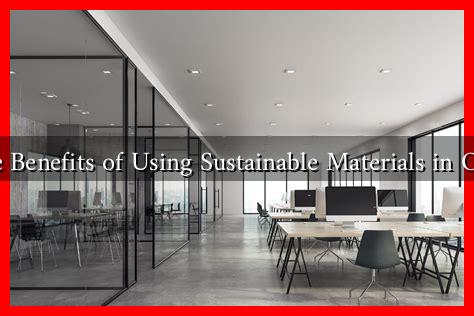-
Table of Contents
What Are the Benefits of Using Sustainable Materials in Office Design?
As businesses increasingly recognize the importance of environmental responsibility, the use of sustainable materials in office design has gained significant traction. Sustainable materials are those that are sourced, produced, and disposed of in ways that minimize environmental impact. This article explores the myriad benefits of incorporating sustainable materials into office design, highlighting their positive effects on employee well-being, cost savings, and corporate reputation.
Enhancing Employee Well-Being
One of the most compelling reasons to use sustainable materials in office design is their positive impact on employee health and well-being. Traditional office materials often contain harmful chemicals that can affect indoor air quality and overall health. In contrast, sustainable materials are typically non-toxic and promote a healthier work environment.
- Improved Indoor Air Quality: Sustainable materials such as low-VOC (volatile organic compounds) paints and finishes help reduce harmful emissions, leading to cleaner air.
- Natural Light Utilization: Sustainable design often incorporates large windows and open spaces, maximizing natural light, which has been shown to boost mood and productivity.
- Biophilic Design: Integrating natural elements, such as wood and plants, can enhance employee satisfaction and reduce stress levels.
For instance, a study by the World Green Building Council found that green buildings can improve employee productivity by up to 11% and reduce absenteeism by 15%. This demonstrates that investing in sustainable materials is not just an environmental choice but also a strategic business decision.
Cost Savings Over Time
While the initial investment in sustainable materials may be higher than traditional options, the long-term cost savings can be substantial. Sustainable materials often lead to lower operational costs through energy efficiency and reduced waste.
- Energy Efficiency: Sustainable materials often include energy-efficient systems and insulation, which can significantly reduce heating and cooling costs.
- Durability: Many sustainable materials are designed to last longer than their conventional counterparts, reducing the need for frequent replacements.
- Waste Reduction: Using recycled materials minimizes waste and can lower disposal costs.
A case study from the Bullitt Center in Seattle, often referred to as the “greenest commercial building in the world,” illustrates these savings. The building’s design incorporates sustainable materials and energy-efficient systems, resulting in a 75% reduction in energy costs compared to conventional buildings.
Enhancing Corporate Reputation
In today’s market, consumers and clients are increasingly favoring companies that demonstrate a commitment to sustainability. Using sustainable materials in office design can significantly enhance a company’s reputation and brand image.
- Attracting Talent: A commitment to sustainability can make a company more attractive to potential employees, particularly among younger generations who prioritize environmental responsibility.
- Client Preferences: Many clients prefer to work with companies that share their values, including sustainability, which can lead to increased business opportunities.
- Positive Public Relations: Sustainable practices can lead to favorable media coverage and community support, enhancing a company’s public image.
For example, tech giant Google has made significant investments in sustainable office design, which has not only improved employee satisfaction but also positioned the company as a leader in corporate sustainability. Their commitment has garnered positive media attention and strengthened their brand loyalty.
Conclusion
Incorporating sustainable materials into office design offers numerous benefits that extend beyond environmental responsibility. From enhancing employee well-being and generating long-term cost savings to improving corporate reputation, the advantages are clear. As businesses continue to navigate the complexities of modern work environments, embracing sustainability in office design is not just a trend but a strategic imperative. By prioritizing sustainable materials, companies can create healthier, more efficient, and more attractive workplaces that resonate with employees and clients alike.
For more information on sustainable office design, consider visiting the World Green Building Council.


